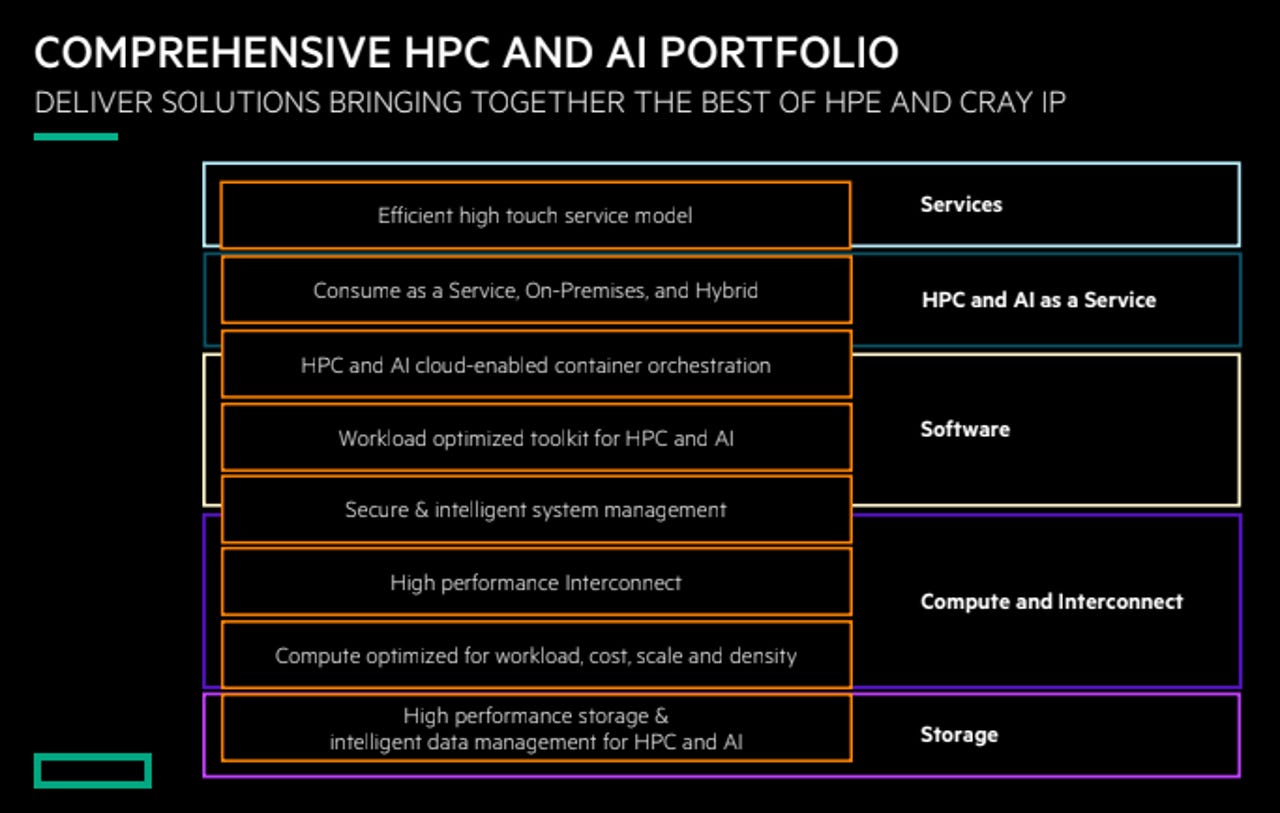HPE unveils revamped HPC portfolio with Cray technology


Six months after its $1.3 billion acquisition of Cray for its high-performance computing (HPC) technology, HPE is unveiling a newly-revamped portfolio that combines HPE and Cray technology to support HPC, AI and analytics workloads. The intent, HPE says, is to offer customers an end-to-end portfolio of services, software, compute, interconnect and storage capabilities for HPC and AI workloads -- delivered on premise or as a service.
Cray is one of the leading players in supercomputing, and its technologies should help HPE ramp up exascale solutions for a range of industries and applications, including modeling and simulation in weather forecasting, the manufacturing and energy sectors, precision medicine, autonomous vehicles, geospatial imaging and financial services.
- SEE: HPE buys supercomputer company Cray for $1.3 billion ¦ Cray lands $600 million contract from DOE to build El Capitan exascale supercomputer ¦ HPE plans to go all-in on everything as a service with heavy dose of Greenlake
"Through the combination of HPE and Cray offerings, we now give customers more choice and control in how they apply HPC, to span any size and scale, running in any environment, from on premises to the cloud," Peter Ungaro, HPE's SVP and GM of HPC and AI, said in a statement.
- As far as compute goes, HPE is extending its portfolio by adding Cray Supercomputers to complement the HPE family of Apollo systems. Customers can now choose from single server solution, all the way up to the largest supercomputers available from Cray. The new Cray systems will be based on the Shasta architecture, is being used to deliver the first three US exascale systems.
- HPE's software for managing HPC and AI systems includes Cray's Shasta System Software, which enables converged HPC and AI workloads to run simultaneously on a single system. It also includes the Cray Programming Environment (CPE), a fully integrated software suite with compilers, tools and libraries for application development and management across complex HPC and AI workloads.
- To address demands for higher speed and lower data latency, HPE is offering Cray Slingshot, a redefined HPC interconnect. Slingshot starts with 200 gbps throughtput and offers unique congestion control cabilities for handling multiple data-intensive workflows simultaneously on a single system.
- For high-performance storage, HPE is offering the recently-introduced Cray ClusterStor E1000. ClusterStor uses intelligent data management software to reduce the need for additional storage drives. Meanwhile, HPE's High Performance Cluster Management (HPCM) software scales to 100,000 nodes.
- The portfolio includes HPE PointNext technical and consulting services to help customers design and accelerate deployments. HPE is bolstering these offerings with Cray's services, including support for installation, troubleshooting, system maintenance, system administration and system optimization.
- Finally, as previously announced Cray and Microsoft are partnering to allow access to HPC technology and systems for Cray in Microsoft Azure offerings. HPE also plans to provide its HPC and AI solutions through HPE GreenLake, its as-a-service offering.
Meanwhile, HPE also announced Monday a collaboration with the US Department of Energy's National Renewable Energy Laboratory (NREL) to research and develop new AI Ops technologies. The goal is to automate and improve the operational efficiency of data centers in the exascale era, particularly as it relates to resiliency and energy usage.
According to federal research, water and energy consumption in US data centers is expected to reach approximately 73 billion kWh and 174 billion gallons of water by 2020.
HPE and NREL are using more than five years' worth of historical data -- more than 16 terabytes of data -- collected from sensors in NREL's supercomputers -- to train models for anomaly detection. This should enable the models to predict and prevent issues before they occur.
The AI Ops project came out of HPE's R&D efforts with PathForward, a DOE-backed program to accelerate the nation's exascale computing roadmap.